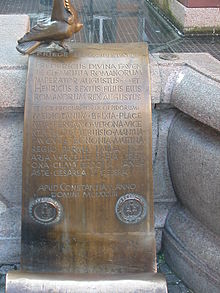
The Peace of Constance (25 June 1183) was a privilege granted by Frederick I, Holy Roman Emperor, and his son and co-ruler, Henry VI, King of the Romans, to the members of the Lombard League to end the state of rebellion (war) that had been ongoing since 1167. It was a permanent peace that superseded the six-year truce imposed by the Treaty of Venice (22 July 1177).[1]
With the expiration of the truce approaching, negotiations between the emperor and the league were begun in early 1183. There were proposals and counter-proposals, a separate settlement of the disputed status of Alessandria and a preliminary agreement signed at Piacenza. The treaty of Piacenza formed the basis for the final peace, which was issued as an imperial privilege because formally the emperor could not sign a treaty with his subjects.[1]
- ^ a b Freed 2016, p. 422–427.